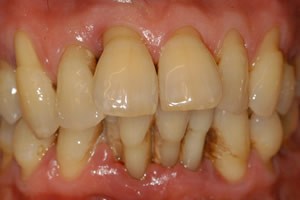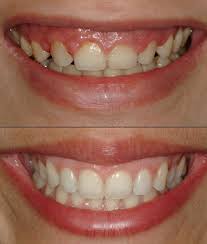Header logo
header top contact widget
Receded Gums
To Floss Or Not? Should It Really Be A Debate?
Posted on Aug 01, 2017 by William J. Claiborne, DDS MS
Most of us see very little of the insides of our mouths. As a matter of fact, until the arrival of intra-oral cameras, it was sometimes challenging to convince patients that they needed treatment for certain things that didn’t hurt.
Intra-oral cameras are designed to give patients, while seated in the treatment chair, clear, enlarged views of specific areas in the mouth. When an individual can see red, receded gums or deep tooth fractures, the decision to treat often changes from IF to WHEN.
As a periodontal specialist, I treat all levels of periodontal disease. Over the years, I’ve helped patients go from nearly losing their natural teeth to saving them and having a healthy, confident smile. It’s impressive when a person goes from taking their oral health for granted to being highly committed.
Yet, I still find myself trying to convince some people that daily flossing is an advantage. It DOES make a difference! According to the Delta Dental Oral Health and Well-Being Survey (http://www.ada.org/en/publications/ada-news/2014-archive/october/survey-finds-shortcomings-in-oral-health-habits):
“Only four of 10 Americans floss at least once a day, and 20 percent never floss.”
Perhaps this is one reason why over 47% of American adults have some level of gum disease, which is also the leading cause of tooth loss. While brushing twice daily helps to remove oral bacteria buildup (a sticky film known as plaque) from tooth surfaces, bits of food caught between teeth aren’t easily dislodged by the bristles of a tooth brush.
Over recent years, a few studies have shown minimal benefit from flossing. Yet, upon closer scrutiny, flaws in the studies were quickly argued. For example, one study followed children who were allowed to floss their own teeth.
It has been noted that the flossing technique can be what makes the action less effective, rather than the act of flossing itself. For example, the American Dental Association recommends curving the floss along the sides of each tooth and firmly, but carefully, motioning it up and down. This moves the floss gently down to reach slightly below where the tooth connects with the gum tissues, getting at the ‘hiding’ spot for much oral bacteria accumulation.
 Like the intra-oral camera, having a firsthand, enlarged view of what’s going on in a mouth is a powerful image. If you looked at a stand of floss under a microscope AFTER flossing your teeth, you’d have a pretty frightening impression of exactly what you DO NOT want crawling around and breeding in your mouth.
Like the intra-oral camera, having a firsthand, enlarged view of what’s going on in a mouth is a powerful image. If you looked at a stand of floss under a microscope AFTER flossing your teeth, you’d have a pretty frightening impression of exactly what you DO NOT want crawling around and breeding in your mouth.
Oral bacteria are micro-organisms. In other words, they’re bugs living and reproducing in the mouth. Saliva flow is designed to help rinse these out during the day. However, brushing thoroughly twice a day is what keeps them to manageable levels.
Flossing grabs those bits that are left behind. If not removed, these left-behind pieces begin to rot and add to bacteria levels in the mouth. Oral bacteria gets its strength in numbers. The more there are, the more rapidly they multiply.
Keeping oral bacteria levels under control takes a commitment, yet requires just minutes a day. The reason your mouth feels ‘fuzzy’ and you feel your breath is bad when it’s dry is because saliva has been depleted and oral bacteria is running rampant. Add sugary foods and beverages and acidic colas and you super-charge oral bacteria further.
As research shows on a continual basis, your overall health is intricately linked to your oral health. The bacteria of gum disease has shown correlations to a number of serious health problems, including everything from heart disease to preterm babies. Obviously, the small amount of time taken to floss daily – and to do it correctly – is worth the advantages of lowering the risk of developing cavities, gum disease and other diseases and conditions.
We are happy to help our patients develop an at-home care regimen that helps them to enjoy a healthy mouth and fresh breath between regular dental check-ups. Call 828-274-9440 to schedule a thorough examination.
Could Gum Health Make You More Likely To Develop Cancer?
Posted on Jul 18, 2017 by William J. Claiborne, DDS MS
Periodontitis is commonly referred to as gum disease or periodontal disease. It begins with Gingivitis, which is an inflammation of the gums, typically due to inadequate oral hygiene. Periodontitis creates an infectious cauldron of bacteria that attacks the structures supporting your natural teeth.
According to research published by the National Institutes of Health (and the U.S. National Library of Medicine), evidence indicates that chronic infections and inflammation such as periodontal disease create an increased risk for developing some cancers. (https://www.ncbi.nlm.nih.gov/pmc/articles/PMC3917197/)
Along the same lines, there is considerable evidence that shows a relationship between bacterial and viral infections and cancer development. Because periodontitis is a bacterial infection, it has warranted more attention in recent decades as a source for other health problems.
For example, it has been determined that arthritis, an inflammation of the joints, and periodontal disease show similarities. When the tissues of both gum disease and RA are examined, their clinical structures are similar with the pathological processes being nearly identical.
Periodontitis creates a cycle that leads to the chronic release of inflammatory cytokines (a substance secreted by immune system cells that effect other cells), prostaglandins (designed to aid in tissue damage recovery), growth factors and enzymes. The combined reactions are closely associated with the development of cancer.
While all of this sounds very scientific and complex, it boils down to something that research has noted time and time again — the oral bacteria of gum disease can trigger harmful reactions elsewhere in the body.
The bacteria of gum disease can enter the bloodstream through weakened oral tissues. Once bloodborne, it can travel throughout the body and create systemic inflammation. Research has already found links between the inflammatory triggers of gum disease and heart disease, stroke, high blood pressure, preterm babies, diabetes, arthritis, erectile dysfunction and impotency.
There has also been research to support a correlation between periodontitis and pancreatic cancer, lung cancer and prostrate cancer. While more research is needed to pinpoint the cause-&-effect, the connection with oral bacteria and the chronic inflammation that can result is established.
Although over 47 percent of American adults have some level of periodontal disease, more education is needed so a stronger proactive stance can be taken. In addition to twice daily brushing and daily flossing, a particular caution should go out to denture and partial wearers. Why?
These appliances can become loose over time due to bone loss that occurs when tooth roots are no longer present in the jaw bone. They can rub sore spots on tender gum tissues in an attempt to chew, which increases susceptibility to gum inflammation.
One of the reasons we are strong proponents of dental implants is their ability to halt bone loss by recreating the presence of missing tooth roots. Additionally, they do not move when eating or speaking, eliminating the possibility of sore spots.
Your oral health is an important component of your overall health. Think of your mouth as the front door to your body. By keeping a healthy smile, your overall health will benefit. And the time and expense to have excellent gum health is so little! Just minutes per day and twice a year visits to your dentist should help you enjoy all the benefits of a clean, fresh smile!
If you’ve fallen behind on dental visits or suspect you have gum disease, begin with a thorough examination by a Periodontist. A Periodontist specializes in gum health and is the expert in treating all levels of gum disease.
Signs of gum disease include sore or bleeding gums (including seeing blood in the sink when brushing), swollen gums, gums that turn red in color, persistent bad breath, pus pockets on gums, gums that recede from teeth, and teeth that eventually loosen.
Remember — gum disease is the leading cause of adult tooth loss. It will only worsen without treatment. Please see a periodontal specialist promptly if you’re experiencing any of these signs. Your entire body will benefit through your commitment to having health gums!
Call 828-274-9440.
The Advantages Of Seeing A Periodontist
Posted on Jul 13, 2017 by William J. Claiborne, DDS MS
Some patients’ periodontal needs can be managed by their general dentist. However, as signs of periodontal disease grow, coupled with research that indicates a correlation between periodontal disease and other chronic diseases, periodontal treatment may resolve at a more effective level through the expertise of a trained specialist. Patients who have moderate or severe levels of periodontal disease, or patients with more complex cases, are often best managed through ‘team treatment’ between a general dentist and periodontal specialist.
What Is A Periodontist? The American Academy of Periodontology explains a periodontist as a “dentist who specializes in the prevention, diagnosis, and treatment of periodontal disease, and in the placement of dental implants. Periodontists are also experts in the treatment of oral inflammation. Periodontists receive extensive training in these areas, including three additional years of education beyond dental school. They are familiar with the latest techniques for diagnosing and treating periodontal disease, and are also trained in performing cosmetic periodontal procedures.
“Periodontists often treat more problematic periodontal cases, such as those with severe gum disease or a complex medical history. Periodontists offer a wide range of treatments, such as scaling and root planing (in which the infected surface of the root is cleaned) or root surface debridement (in which damaged tissue is removed). They can also treat patients with severe gum problems using a range of surgical procedures.
In addition, periodontists are specially trained in the placement, maintenance, and repair of dental implants.”
On their web site, the American Academy of Periodontology lists the symptoms of gum disease as:
- Red, swollen or tender gums or other sore areas in your mouth
- Bleeding while brushing or flossing
- Gums that recede or pull away from teeth, causing the teeth to look longer than before
- Loose or separating teeth
- Pus pockets between your gums and teeth
- Persistent bad breath
- A change in the way your teeth fit together when you bite
- A change in the fit of partial dentures
Additionally, the site features an explanation of the various stages of gum disease (https://www.perio.org/consumer/types-gum-disease.html).
Please know that you do not have to be referred to our office for care. While we want you to receive regular dental care once your mouth is restored to optimal health, we can suggest a general dentist for you if you do not have one.
Our goal is to ensure you are receiving the care you need to be healthy and to keep your natural teeth. As research continues to show, the health of your mouth has an impact on the health of your body.
Begin with a consultation or ask for a thorough periodontal exam by calling 828-274-9440. Let our specialty restore your teeth and gums to good health and confident smiles!
Reshaping Gum Tissues Can Greatly Improve Smile’s Appearance
Posted on Jun 07, 2017 by William J. Claiborne, DDS MS
As a Periodontist, I have advanced training and skills in the placement of Dental Implants and treating all stages of periodontal (gum) disease. Another realm of the periodontal specialty is in the recontouring of gum tissues, referred to as Periodontal Plastic Surgery.
While the shape, shade and length of teeth have a major impact on the appearance of a smile, so does the gum tissues that frame each tooth. The uniformity of gum tissues creates an appealing balance of gums to teeth. Thus, the appearance of your smile is greatly affected by the appearance of teeth and their ‘frames’ of gum tissue.
There are several ways that gum reshaping can have a dramatic impact on a smile’s appearance. Gum reshaping is recommended when certain teeth are bordered by more gum tissue than that which borders surrounding teeth. The procedure to correct this is crown lengthening, which is usually done in conjunction with crown placement.
Crown lengthening provides an appealing, balanced smile line that ‘frames’ each tooth with an arch similar to that over adjoining teeth. The procedure requires just one visit and healing time is generally minimal.
However, crown lengthening may also be performed to save a tooth from removal. For example, when a tooth has broken close to the gum line, crown lengthening procedures can remove gum tissue to expose more of the tooth. Because a tooth that breaks at the gum line must be removed, this procedure can make sufficient tooth structure available to support a crown.
Crown lengthening is also beneficial in sealing gum tissues surrounding a tooth at its base. This is important after a new crown is placed as it prevents bacteria from penetrating the gums during the vulnerable stage of attaching. By securing the gum tissue around the crown, bacterial entry is avoided and the risk for periodontal (gum) disease decreased.
Another way that Periodontal Plastic Surgery can enhance both the health and appearance of a smile is grafting to repair gum recession. This is when the gum tissue pulls away from the base of the tooth, exposing darker, more sensitive tooth root sections. Causes of receded gums are often due to age, bite misalignment, gum disease and over-zealous brushing.
Also referred to as Gingival Grafting, this procedure typically involves taking a small area of tissue from the roof of your mouth (which heals quickly) and placing it over the area of recession. It is secured in place for a healing period of approximately two weeks. The results restore the look of a healthy, naturally-framed tooth.
For those who are born with a ‘gummy smile,’ gum reshaping can restore the balance of gums to teeth for a more appealing smile. In a gummy smile, too much gum tissue is exposed above the teeth most visible in a smile. This is a genetic trait and doesn’t affect one’s oral health. However, many who have this particular smile trait feel self-conscious when they smile and tend to hold back from smiling fully.
The procedure to correct a gummy smile is a gingivectomy and can be done in one visit. Excess gum tissue is removed and the remaining gums are shaped to arch over each tooth for a natural appearance. In most cases, porcelain crowns or veneers are placed to accentuate the natural look and feel of the teeth involved.
A Periodontal Specialist provides you with advanced skills for these procedures. He or she also understands the delicate touch needed for minimal disruption to the gums involved in treatment. This tender tissue requires precision care to provide exceptional results with minimal healing time needed.
If Periodontal Plastic Surgery could improve the appearance and health of your smile, call 828-274-9440 to schedule a consultation appointment. During this time, we can discuss the options that would work best for your needs.
Recent Posts
Categories
Archives
- September 2024
- August 2024
- July 2024
- June 2024
- May 2024
- April 2024
- March 2024
- February 2024
- January 2024
- December 2023
- November 2023
- October 2023
- September 2023
- August 2023
- July 2023
- June 2023
- May 2023
- April 2023
- March 2023
- February 2023
- January 2023
- December 2022
- November 2022
- October 2022
- September 2022
- August 2022
- July 2022
- June 2022
- May 2022
- April 2022
- March 2022
- February 2022
- January 2022
- December 2021
- November 2021
- October 2021
- September 2021
- August 2021
- July 2021
- June 2021
- May 2021
- April 2021
- March 2021
- February 2021
- January 2021
- December 2020
- November 2020
- October 2020
- September 2020
- August 2020
- July 2020
- June 2020
- May 2020
- April 2020
- March 2020
- February 2020
- January 2020
- December 2019
- November 2019
- October 2019
- September 2019
- August 2019
- July 2019
- June 2019
- May 2019
- April 2019
- March 2019
- February 2019
- January 2019
- December 2018
- November 2018
- October 2018
- September 2018
- August 2018
- July 2018
- June 2018
- May 2018
- April 2018
- March 2018
- February 2018
- January 2018
- December 2017
- November 2017
- October 2017
- September 2017
- August 2017
- July 2017
- June 2017
- May 2017
- April 2017
- March 2017
- February 2017
- January 2017
- December 2016
- November 2016
- October 2016
- September 2016
- August 2016
- July 2016
- June 2016
- May 2016
- April 2016
- March 2016
- February 2016
- January 2016
- December 2015
- November 2015
- October 2015
- September 2015
- August 2015
- July 2015
- June 2015
- May 2015
- April 2015
- March 2015
- February 2015
- January 2015
- December 2014
- November 2014
- October 2014
- September 2014
- August 2014
- July 2014
- June 2014
- May 2014
- April 2014
- March 2014
- February 2014
- January 2014
- December 2013
- November 2013
- October 2013
- September 2013
- August 2013
- July 2013
- June 2013
- May 2013
- April 2013
- March 2013
- February 2013
- January 2013
- December 2012
- November 2012
- October 2012
- September 2012
- August 2012
- July 2012
- June 2012




